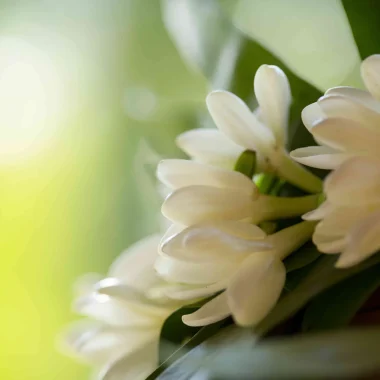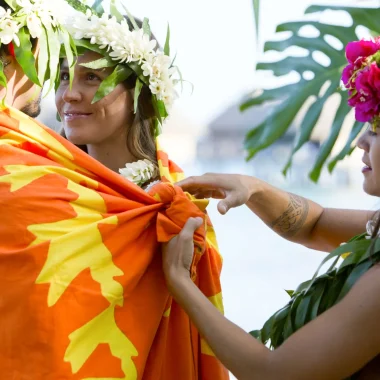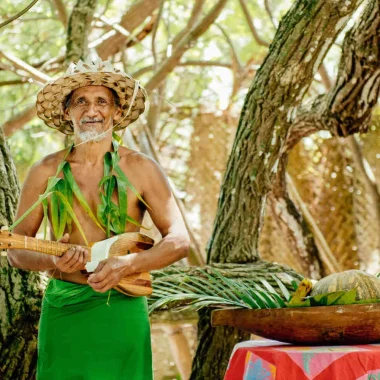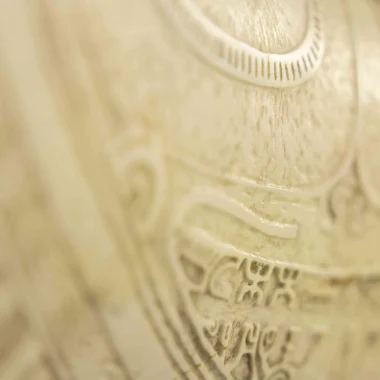In the mystical depths of French Polynesia there are treasures sculpted by the skilled hands of local craftsmen. They are called tiki. These sculpted statues have very distinct features, half man and half god. They look a lot like men, but their eyes are huge almonds, representing windows into the afterlife. Tiki symbolize power, knowledge, wisdom and wealth. They represent the force of Polynesian art and the richness of the Ma’ohi culture.
The ancient Polynesian craftsmen brought life to their tiki, sculpting the stone with skill and passion. The statuettes found in traditional craft workshops today are smaller versions, sculpted in wood, stone or bone, with the same aesthetic values and cultural significance as their illustrious ancestors on archeological sites throughout The Islands of Tahiti. Kauri is the wood of choice used by today’s sculptors, or sometimes they use the wood of the coconut tree. Both are noble materials that can be transformed into vibrant works of art. Volcanic stone, brings a sense of timelessness to the tiki. Bone is more delicate and portrays the fragility of existence, and such tiki are very precious. Craftsmen sometimes sculpt in other materials, such as nacre, coral or the flower stones of Ua pou in the Marquesas Islands. Tiki originated in the beautiful, enchanted island of Raivavae, a jewel of French Polynesia in the Austral Islands. The skills of the local craftsmen are transmitted from generation to generation in these remote and isolated islands, perpetuating the ancestral traditions. The semi-divine tiki of Raivavae are protective totems and possessors of magical powers.
A tiki as a souvenir of French Polynesia
Tiki statuettes are treasures that you can take home with you; small jewels charged with emotion. Each one is a small part of the Mana of Polynesia, the spirit of the ancient culture. Tiki now come in all sizes: big tiki, large enough to be a stand-alone decoration in a sitting room or hallway; smaller versions that will add a pleasing, exotic touch to a book case; and tiny models that you could put on a keyring, wear as a pendant round your neck or even have made into earrings.



Among the many famous tiki in The Islands of Tahiti, the three tiki of Raivavae stand out because of their turbulent past. They were taken by boat from the island to Tahiti in 1922 and one of them was lost overboard in the lagoon. The two others now reside in the gardens of the Gauguin Museum in Papeari, having been moved several times. According to Polynesian culture, it is sacriligeous to displace a tiki and indeed, a long series of inexplicable deaths and accidents arrived to all those involved in the various transfers. A campaign has been launched by the islanders to have the tiki returned to their original site.
The mythical tiki of Hiva Oa
An imposing tiki rules over the archeological site at Puamau on the island of Hiva Oa. Named Takaii, after an ancient warrior chief, it is a powerful, kindly giant that inspires respect and admiration. Visitors often talk of an energy that seems to emanate from this 8 feet high statue. That energy is known in Polynesia as the Mana.

There are many other tiki in the Marquesas Islands, including the famous elephant tiki in the valley of Hokatu, on the island of Ua Huka. It was discovered in 1982 in the middle of a forest and has since become the symbol of the island. Visitors hiking through the hills and valleys of the Marquesas Islands will come across tiki in the many archeological sites, especially on the island of Hiva Oa. Some of the best-known tiki of the Marquesas Islands are the three tiki in Ua Huka known as the Meiaute triplets, and the Tapuivi tiki, guardian of Aakapa and the eleven tiki of Paeke in Nuku Hiva.
Themes









 América del Sur
América del Sur
 Australia
Australia
 Belgique
Belgique
 Brasil
Brasil
 Canada (EN)
Canada (EN)
 Canada (FR)
Canada (FR)
 Deutschland
Deutschland
 España
España
 France
France
 Italia
Italia
 Mexico
Mexico
 Polynésie française
Polynésie française
 New Zealand
New Zealand
 Schweizerisch (DE)
Schweizerisch (DE)
 Suisse (FR)
Suisse (FR)
 United Kingdom
United Kingdom
 United States
United States
 한국
한국
 中国
中国
 日本
日本